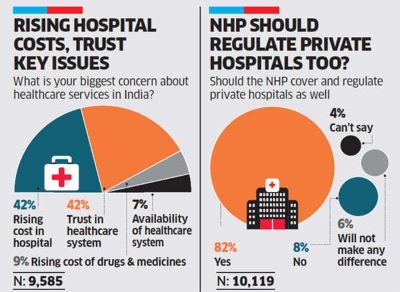Context
The Supreme Court of India, in response to a Public Interest Litigation (PIL) earlier this year, directed the central government to explore methods of regulating hospital procedure rates within the private sector. This directive stemmed from concerns over the high costs and significant variations in procedure rates across different healthcare establishments. Notably, the Court cited the example of cataract surgeries, which cost a mere ₹10,000 in government facilities but range from ₹30,000 to ₹1,40,000 in private hospitals. The Court invoked Rule 9 of the Clinical Establishments (Registration and Regulation) Act, 2010, underscoring the necessity for clinical establishments to adhere to rates determined by the Central Government, in consultation with State Governments.
India's healthcare landscape predominantly relies on private providers, with prices determined by market forces. However, the lack of regulation in this sector has led to inefficiencies and disparities in access to care. While the Court's intervention highlights a pressing issue, the proposed solution of rate regulation oversimplifies the complexities inherent in healthcare pricing. Nevertheless, it serves as a catalyst for initiating discussions and actions to address these challenges effectively.
Benchmark for Pricing
In an unregulated market environment, healthcare providers often prioritize profit maximization through inflated prices and overprovision of care, leading to supplier-induced demand. One potential solution to this issue is the concept of "yardstick competition," wherein regulatory authorities establish benchmark prices based on market observations. However, implementing this approach in India presents challenges due to diverse patient demographics, unreliable price data, and inadequacies in regulatory frameworks. Additionally, relying solely on competition from government hospitals proves insufficient, given concerns regarding long wait times, perceived quality issues, and information gaps among patients, thereby perpetuating the risk of supplier-induced demand.
As emphasized by the Court, discussions regarding pricing necessitate the establishment of a benchmark for price determination. Standard treatment guidelines (STGs) emerge as a viable tool for this purpose, as they delineate clinical requirements, the nature of care, and the associated costs for various medical procedures. STGs accommodate confounding factors influencing the level of care required for different procedures while allowing for clinical autonomy to address individual patient needs. Consequently, they facilitate the valuation of healthcare resources utilized in delivering specific procedures, thereby enabling more accurate pricing.
However, the successful formulation and adoption of STGs hinge upon providers' reliance on a limited number of payers for their revenue. Achieving this entails transitioning towards a system where providers are reimbursed through pooled payments, thereby minimizing out-of-pocket expenses for patients. Collaborative efforts between payers and providers, supported by government initiatives, are imperative for establishing pricing structures that ensure a reasonable surplus over input costs while maintaining sustainability. Nevertheless, the implementation of such measures may encounter obstacles if providers have access to alternative markets where out-of-pocket payments prevail. This underscores the need for coordinated healthcare purchasing reforms to address pricing challenges comprehensively.
Weak Implementation
Command-and-control regulations, such as price caps, can exert immediate influence on stakeholders' behavior by compelling adherence to mandated rates. However, the efficacy of such measures is contingent upon robust enforcement mechanisms. In India, the implementation of regulatory frameworks like the Clinical Establishments Act remains weak, with only a fraction of states and union territories notifying its provisions. This limited enforcement capacity undermines the effectiveness of price regulation initiatives, as evidenced by the challenges encountered in implementing price caps on medical devices since 2017.
Moreover, the misalignment of incentives among stakeholders presents a fundamental challenge that rate standardization alone may not address. A holistic health financing reform strategy, informed by ongoing research on the formulation and adoption of STGs, is indispensable for addressing pricing issues effectively. Without standardized guidelines, verifying claims regarding care quality becomes arduous, thereby impeding efforts to ensure fair pricing practices across healthcare establishments.
Limited Data
Efforts to address pricing disparities in healthcare are further complicated by the dearth of representative and accurate costing data. While initiatives such as the Pradhan Mantri Jan Arogya Yojana and the development of Standard Treatment Guidelines (STGs) for common conditions demonstrate progress, challenges persist in creating a comprehensive framework for cost determination. The insurance industry's attempt to establish STGs for hospitals in 2010 was hampered by limited participation from private healthcare providers, resulting in inadequate data to inform pricing decisions.
Conclusion
The Supreme Court's directive to regulate hospital procedure rates underscores the urgency of addressing pricing disparities in India's healthcare system. However, the complexity of this issue necessitates a nuanced approach that goes beyond mere rate standardization. While Standard Treatment Guidelines (STGs) offer a promising framework for establishing benchmark prices, their successful implementation hinges upon robust enforcement mechanisms and collaborative efforts between stakeholders. Additionally, addressing pricing disparities requires comprehensive health financing reforms informed by accurate costing data and ongoing research. By leveraging existing initiatives and fostering broader stakeholder participation, India can move closer to achieving equitable and affordable healthcare for all its citizens.
|
Probable Questions for UPSC Mains Exam
|
Source — The Hindu







